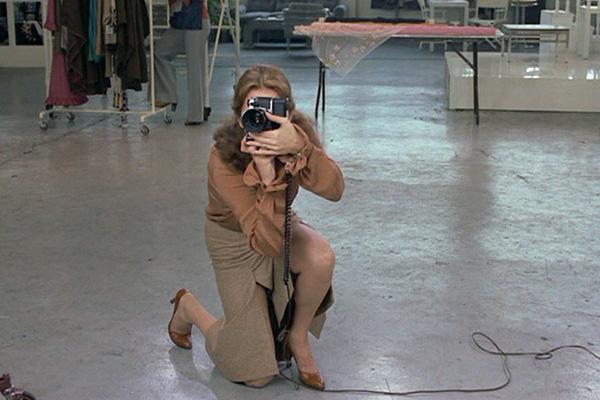
The Eyes of Laura Mars (Movie Review)
In 1978 John Carpenter’s “Halloween” became a surprise smash hit which redefined the horror film and introduced audiences to the slasher genre which would go on to dominate drive-ins throughout the next decade. Many people don’t realize that “Halloween” wasn’t the only John Carpenter film released that year. “The Eyes of Laura Mars”, based on a screenplay Carpenter had written on spec years earlier, boasted an Oscar winner in the lead (Faye Dunaway), a bevy of future stars (Tommy Lee Jones, Raul Julia, Brad Dourif), and a director (Irvin Kirschner) whose next project would become one of most iconic films of all time (“The Empire Strikes Back”). Though it was a modest hit at the time, today “Laura Mars” is a mostly forgotten footnote in film history while Michael Myers is an internationally recognized phenomenon.
John Carpenter has frequently mentioned giallo films as a major influence on “Halloween” and the Italian influence is even more noticeable in “Laura Mars”. In fact, it wouldn’t be incorrect to call “Laura Mars” an American giallo. It features camerawork from the POV of a gloved killer, pointy objects being jammed into eyes, frequently topless high fashion models, obvious red herrings and a groan-inducing and unsurprising twist ending. If the dialogue was overdubbed with cheesy voice acting this could almost pass for some long-lost minor Sergio Martino movie.
Laura Mars is the hottest photographer on the New York art scene, generating headlines with her provocative photos of half-naked models arranged in various states of violence and death. Mars gets her inspiration from visions that come to her out of the blue, visions that bear a close resemblance to many recent crime scenes across the city. As her visions get worse, she begins to see her friends and colleagues being murdered violently through the eyes of their killer. With the help of a handsome detective she attempts to discover the murderer in her midst.
What prevents “Laura Mars” from becoming the equal of its continental cousins is its reluctance to embrace the pure sleaziness that lies at the heart of all great giallos. Giallo traces its roots directly back to lurid pulp novels and the best examples of the style are just as disreputable as the source material. “Laura Mars” does an admirable job of dancing along the borderline of acceptability and isn’t entirely watered down for American audiences, but in the end it becomes that all-too-familiar Frankenstein monster of American culture – the sleazy trash that’s embarrassed to admit what it is and instead tries to gussy itself up as something respectable. There’s enough nudity and crash zooms on display to whet the appetite of a giallo fan but they’ll most likely be calling shenanigans on a film about an ice-pick-wielding, eyeball-gouging serial killer which refuses to even show, much less linger on, the violence.
The acting is fairly hammy across the board but in a giallo overacting isn’t just acceptable, it’s practically a requirement. Typically, though, giallos star a mix of obscure Italian actors, washed up refugees from American television and John Saxon. It’s highly entertaining to see Faye Dunaway and Tommy Lee Jones do their best with such a goofy, nonsensical plot. Brad Dourif deserves special mention not only because Brad Dourif always deserves special mention but also because he puts in a performance that mostly consists of being gruff, crazy-eyed, and having a beard, which are three thing Brad Dourif excels at.
The film really goes off the rails in the end. No explanation is given for Laura’s extraordinary power and no attempt is even made to tie her abilities into the killer’s story. The identity of the killer isn’t much of a surprise and is made even less of a surprise by the film’s sloppy final scene which makes it obvious who the killer is five minutes before the big reveal scene.
“The Eyes of Laura Mars” reportedly changed many elements of the original screenplay and a John Carpenter fan could be forgiven for suspecting that a much better script was buried beneath all the camp and schlock. Even with all its flaws, this film is a must-see for Carpenter completists and it could be a good entry point for someone wanting to dip their toe into the pool of giallo films. Knowledgeable giallo fans might get a kick out of seeing a Hollywood take on the style but once the initial novelty wears off they’ll be left with a fairly mediocre and watered-down effort which might be of some historical interest but in the end isn’t really worth a second look.

